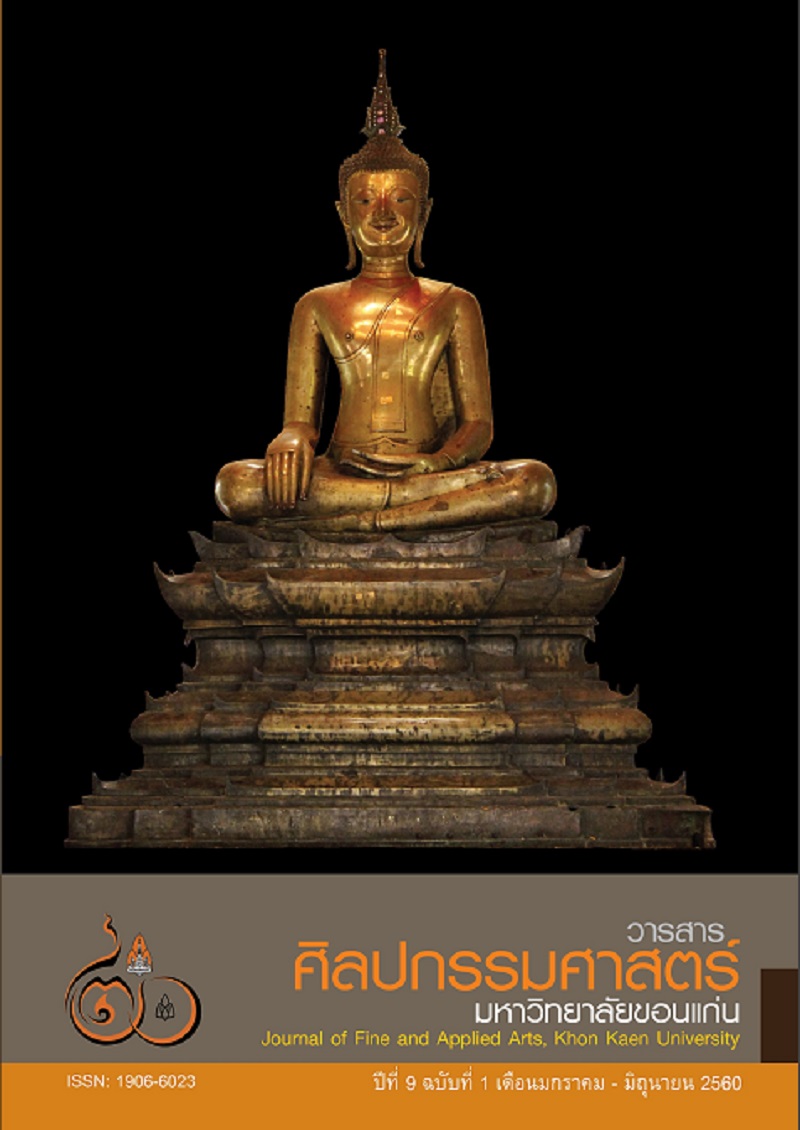การประยุกต์ใช้อัตลักษณ์อีสานในการออกแบบตกแต่งภายในห้องรับประทานอาหาร The Application of Isan Identities through Restaurants’ Interior Designs
Main Article Content
Abstract
การวิจัยครั้งนี้ มีวัตถุประสงค์เพื่อวิเคราะห์การประยุกต์ใช้อัตลักษณ์อีสานในการออกแบบตกแต่งภายในห้องรับประทานอาหาร โดยผู้วิจัยศึกษาวิเคราะห์ร้านอาหารในจังหวัดต่าง ๆ ของภาคตะวันออกเฉียงเหนือ จำนวน 3 แห่ง ได้แก่ ร้านอาหารเฮือนหลวงพระบาง อำเภอเชียงคาน จังหวัดเลย ห้องอาหารกุฉินารายณ์ โรงแรมริมปาว อำเภอเมือง จังหวัดกาฬสินธุ์ และศูนย์อาหาร เซ็นทรัลพลาซ่า จังหวัดอุดรธานี พร้อมสัมภาษณ์ผู้เกี่ยวข้องและผู้เชี่ยวชาญ 3 กลุ่ม ได้แก่ เจ้าของร้านอาหาร ผู้เชี่ยวชาญด้านการออกแบบภายใน และผู้เชี่ยวชาญด้านอัตลักษณ์อีสาน
ผลการศึกษาพบว่าสามารถแบ่งแนวทางในการนำอัตลักษณ์อีสานมาใช้ในการออกแบบตกแต่งภายในห้องอาหารได้เป็น 3 กลุ่ม ได้แก่ ความเชื่อภายในท้องถิ่น เครื่องใช้ของคนในท้องถิ่น และประเพณีวัฒนธรรมท้องถิ่น โดยมัณฑนากรให้ความสำคัญกับการเลือกสรร ปรับ แปลง ปรุง เพิ่ม หรือ ลดทอน สัญลักษณ์ที่สื่อถึงอัตลักษณ์อีสานที่เกี่ยวข้องกับท้องถิ่นของตนมาใช้ในการออกแบบโดยไม่สูญเสียความหมาย หรือขัดต่อคติความเชื่อของคนในท้องถิ่น อีกทั้งยังคำนึงถึงการจัดวางอัตลักษณ์ในตำแหน่งที่เหมาะสม และสัมพันธ์กลมกลืนกับบริบทแวดล้อมของอาคารหรือพื้นที่นั้นๆ ทั้งนี้เพราะอัตลักษณ์ดังกล่าว นอกจากจะมีความสำคัญในฐานะเป็นสัญลักษณ์ทางวัฒนธรรมที่สามารถสื่อความหมายและรับรู้เข้าใจระหว่างคนในพื้นที่เองแล้วยังสามารถสื่อความหมายให้ผู้อยู่นอกวัฒนธรรมเข้าใจถึงอัตลักษณ์ทางวัฒนธรรมในถิ่นนั้นๆ ได้โดยง่ายอีกด้วย
This article aims to analyze the application of Isan identities in restaurants’ interior designs. Purposive sampling is used in the analysis of three restaurants in the northeast, consisting of HuanLuangPrabang in Chiang Khan District of Loei Province, Kuchinarai Restaurant in Rimpao Hotel in Muang District of Kalasin Province, and Central Plaza Food Court in UdonThani Province. Three groups of experts and related persons, including restaurants owners, interior design experts and Isan identity experts, were interviewed.
The results reveal that the application of Isan identities in restaurants’ interior designs can be divided into three groups: local belief, local equipment and local tradition and culture. In addition, it is found that the interior decorators emphasized on the selection, adjustment, adaptation, addition or reduction of symbols representing Isan identities that are related to the locals in their designs without losing its meaning or being against the local belief. Moreover, placing the identities in appropriate positions and in harmonious context of the facility or area are found to be considered by the interior decorators. This is because the identities, besides, are important as cultural symbols that can convey meaning and recognition between the locals; they can also culturally present the meaning to the outsiders in order to simply understand the cultural identities.
Article Details
Content and information in articles published in the Journal of Fine and Applied Arts of Khon Kaen University is regarded as the opinion and sole responsibility of the author(s) directly; therefore, editors are not obliged to agree to or share any responsibility with regard to the content and information that appears within these articles.
All articles, information, content, image, etc. that have been published in the Journal of Fine and Applied Arts of Khon Kaen University is the copyright of the Journal of Fine and Appllied Arts of Khon Kaen University. Any person or organization who wishes to distribute all or parts of the articles for further dissemination or other usage must first receive permission from the Journal of Fine and Applied Arts of Khon Kaen University before proceeding to do so.


